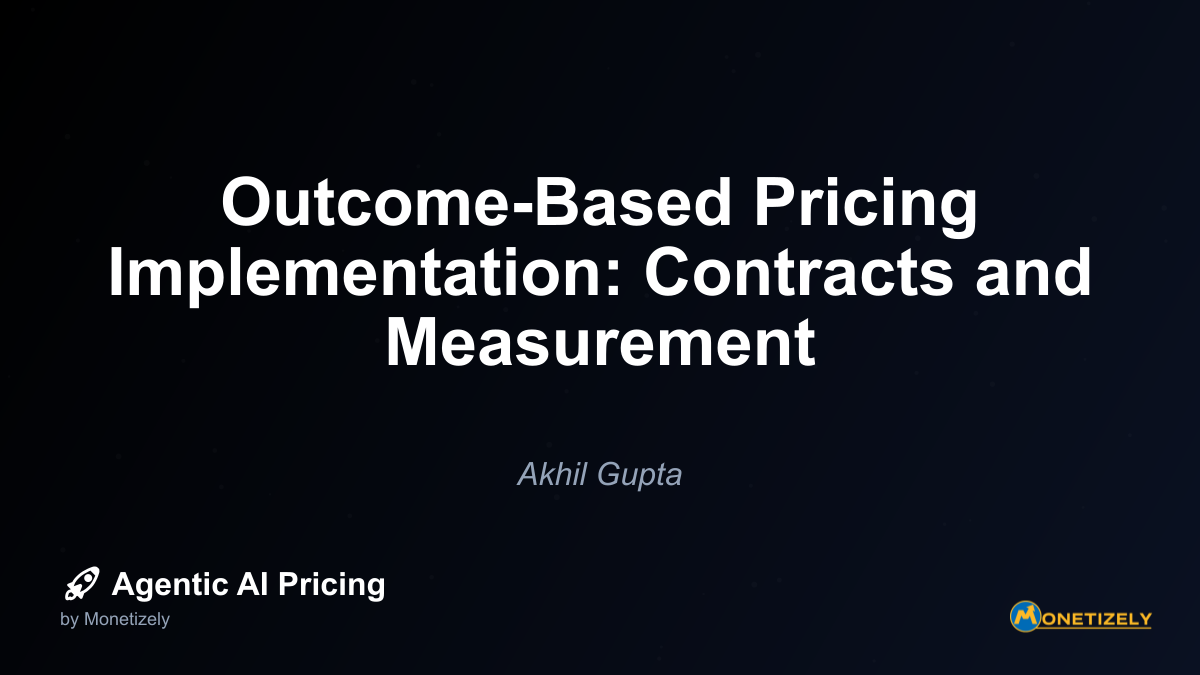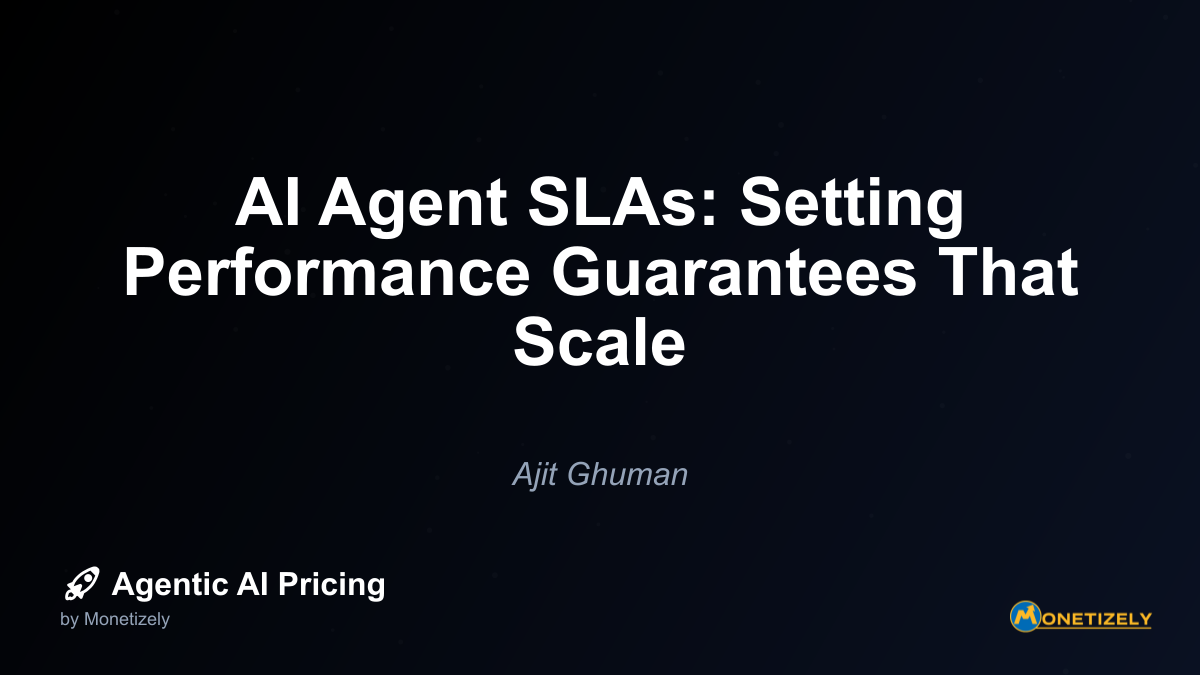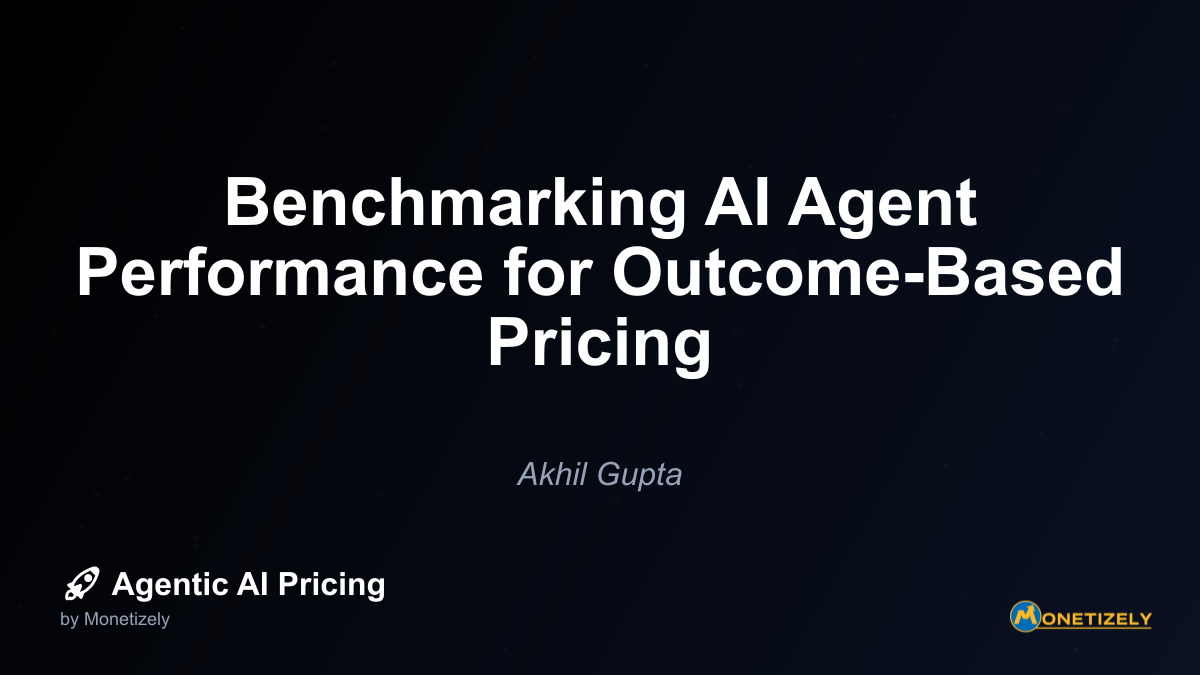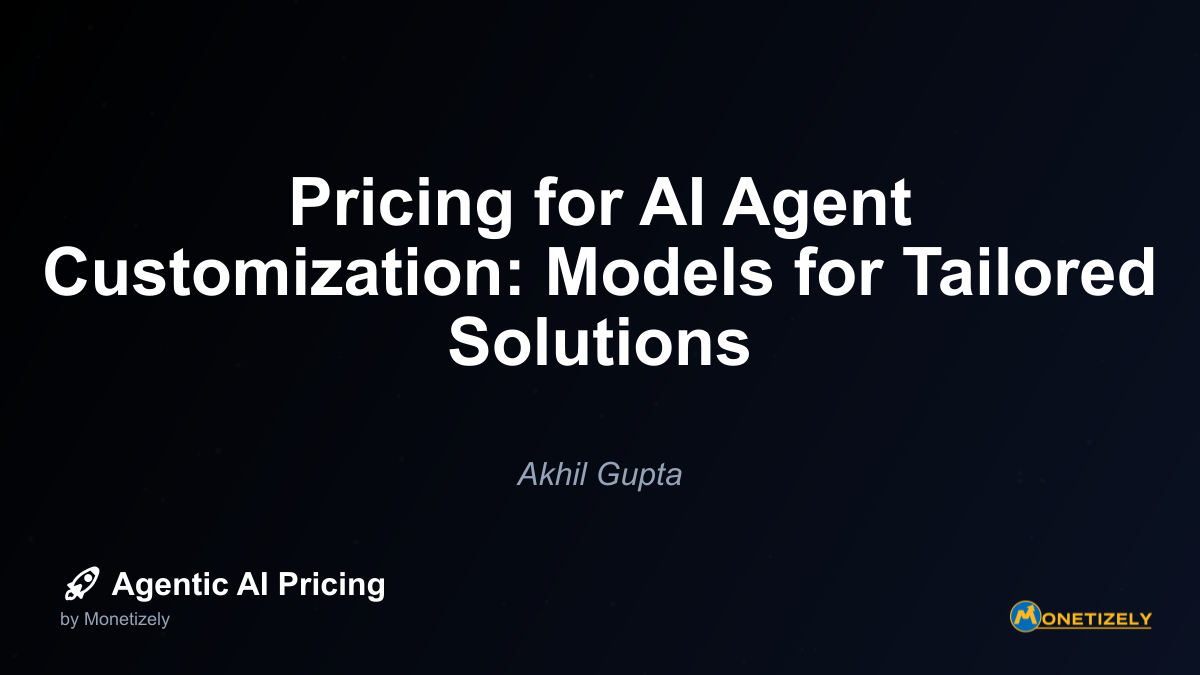· Akhil Gupta · Implementation · 13 min read
Structuring True Outcome-Based Pricing for AI Solutions
AI and SaaS Pricing Masterclass
Learn the art of strategic pricing directly from industry experts. Our comprehensive course provides frameworks and methodologies for optimizing your pricing strategy in the evolving AI landscape. Earn a professional certification that can be imported directly to your LinkedIn profile.
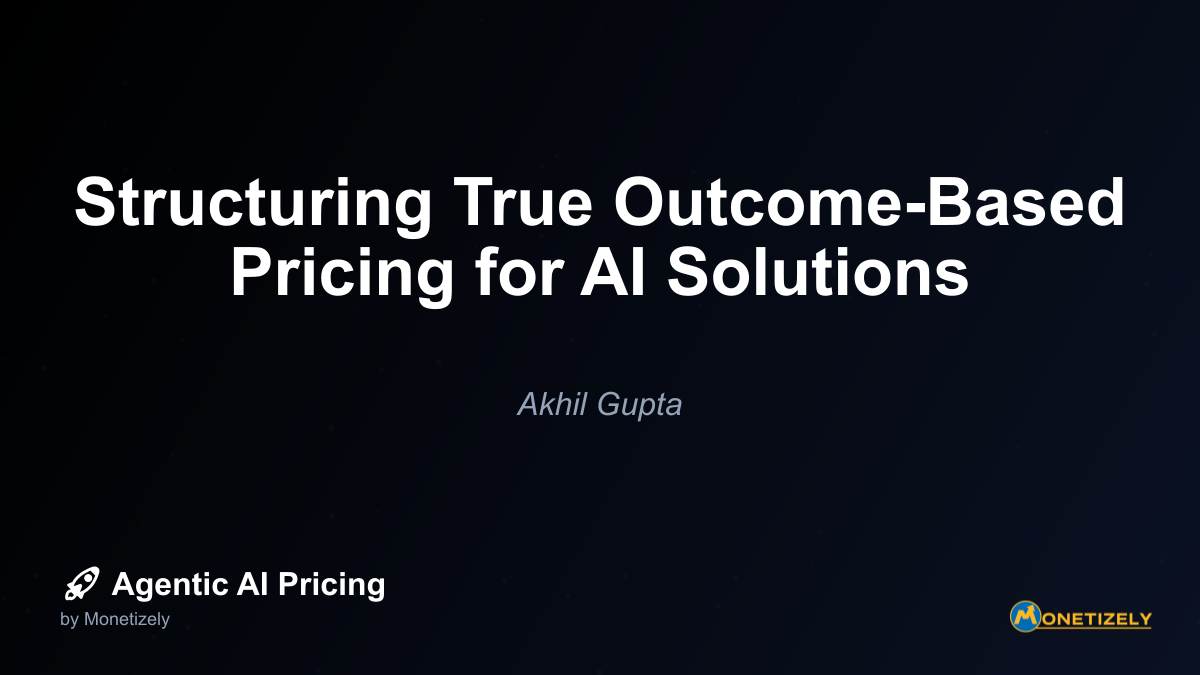
In the rapidly evolving landscape of artificial intelligence, the question of how to price AI solutions has become increasingly complex. Traditional pricing models based on seats, licenses, or usage metrics often fail to capture the true value these technologies deliver. This disconnect has led to the emergence of outcome-based pricing—a model that directly ties payment to the measurable business results an AI solution generates.
Outcome-based pricing represents a fundamental shift in how technology is monetized. Rather than paying for the tool itself, customers pay for what the tool accomplishes. This approach aligns incentives between vendors and buyers, reduces initial investment risks, and focuses everyone on what truly matters: business impact.
This comprehensive guide explores the frameworks, methodologies, and practical considerations for implementing true outcome-based pricing for AI solutions. From contract structures to risk-sharing mechanisms, measurement methodologies to dispute resolution, we’ll provide the strategic roadmap you need to successfully implement this transformative pricing approach.
The Evolution Toward Outcome-Based Pricing in AI
The pricing of AI solutions has undergone significant evolution in recent years. Traditional models that once dominated the landscape are increasingly being challenged by more sophisticated approaches that better reflect the value AI delivers.
From Inputs to Outcomes: The Shifting Paradigm
Traditional pricing models for software and technology solutions have historically focused on inputs: the number of users (seat-based), computing resources consumed (usage-based), or access rights (license-based). While straightforward to implement and understand, these models create a fundamental misalignment between what customers pay for and the value they receive.
Recent market data illustrates this shift dramatically. According to industry research, seat-based pricing for AI products has declined sharply, dropping from 21% to 15% of companies over just 12 months, while hybrid pricing models incorporating usage and outcome elements have surged from 27% to 41%.
This transition reflects a deeper understanding that AI’s true value lies not in its consumption but in its results—the business outcomes it enables. Companies using outcome-based pricing report 27% higher vendor satisfaction and 31% better ROI compared to traditional models, according to McKinsey research.
Why Traditional Pricing Models Fall Short for AI
Traditional pricing approaches present several limitations when applied to AI solutions:
Value Disconnect: Customers may pay the same amount regardless of whether the AI delivers transformative results or minimal impact.
Risk Imbalance: The financial risk falls disproportionately on the buyer, who must invest upfront with uncertain returns.
Innovation Disincentives: Vendors have limited financial motivation to continuously improve their solutions once the sale is complete.
Budget Justification Challenges: Decision-makers struggle to justify AI investments when costs are disconnected from measurable returns.
As AI capabilities have matured, the limitations of these traditional models have become increasingly apparent. Customers now demand pricing structures that reflect the actual business value delivered, leading to the rise of outcome-based approaches.
Market Drivers Behind Outcome-Based Pricing
Several factors are accelerating the shift toward outcome-based pricing for AI solutions:
Economic Pressure: In challenging economic environments, organizations face increased scrutiny on technology investments, demanding clear ROI.
AI Maturity: As AI solutions mature, they can more reliably deliver measurable business outcomes.
Competitive Differentiation: Vendors use outcome-based pricing as a competitive advantage, demonstrating confidence in their solutions.
Enterprise Demand: Sophisticated buyers increasingly expect pricing aligned with business results rather than technical metrics.
Technology Enablement: Advanced analytics and monitoring tools make it feasible to track and attribute outcomes with greater precision.
According to BCG, 40% of IT buyers cite seat reduction as their primary lever for lowering software costs, accelerating the move toward agent- and outcomes-based pricing around AI solutions. Meanwhile, Andreessen Horowitz finds that 73% of AI companies are still experimenting with pricing, indicating ongoing market evolution toward outcome-based strategies.
Core Frameworks for Outcome-Based Pricing
Implementing outcome-based pricing requires structured frameworks that define how outcomes are measured, how payments are calculated, and how risk is shared between parties.
Defining Success: Outcome Metrics and KPIs
The foundation of any outcome-based pricing model is a clear, mutually agreed-upon definition of success. This requires identifying the specific metrics that will determine payment. Effective outcome metrics typically share several characteristics:
Measurability: Outcomes must be quantifiable through objective data rather than subjective assessment.
Attributability: The impact of the AI solution must be distinguishable from other factors affecting the outcome.
Relevance: Metrics should directly connect to business value that matters to the customer.
Timeliness: Outcomes should be measurable within a reasonable timeframe to align with payment cycles.
Controllability: While not entirely within the vendor’s control, outcomes should be substantially influenced by the AI solution’s performance.
Common categories of outcome metrics include:
- Revenue metrics: Sales growth, conversion rates, customer acquisition costs
- Cost reduction metrics: Operational savings, efficiency gains, resource optimization
- Risk mitigation metrics: Fraud prevention, error reduction, compliance improvements
- Customer experience metrics: Satisfaction scores, resolution rates, engagement metrics
- Operational metrics: Process acceleration, quality improvements, throughput increases
For example, a customer service AI might be measured on successful query resolutions without human intervention, while a sales AI might be evaluated based on qualified opportunities generated or conversion rate improvements.
Baseline Establishment Methodologies
A critical element in outcome-based pricing is establishing the baseline against which improvements will be measured. Without a reliable baseline, it becomes impossible to quantify the value the AI solution delivers. Several approaches to baseline establishment include:
Historical Performance Analysis: Using the customer’s historical data to establish pre-implementation performance levels.
Control Group Comparison: Maintaining a segment of operations without the AI solution to compare against the implemented areas.
Industry Benchmarking: Using industry standards or averages as reference points when historical data is unavailable.
Pilot Period Measurement: Conducting a limited implementation period to gather baseline data before full deployment.
Simulation Modeling: Using predictive models to establish theoretical baselines when direct measurement isn’t possible.
The baseline establishment process should be collaborative, transparent, and documented in the contract to prevent future disputes. It may include provisions for baseline adjustments to account for significant business changes, market shifts, or other external factors that could skew comparisons.
Financial Models and Pricing Formulas
Once outcomes and baselines are defined, the next step is determining how payments will be calculated based on performance. Several financial models have emerged for outcome-based AI pricing:
Performance Tier Pricing: Establishing fixed fee levels tied to performance thresholds.
- Example: Tier 1: 70-80% success rate → base fee; Tier 2: 81-90% → higher fee; Tier 3: 91%+ → premium fee
Pay-Per-Outcome: Charging a set amount for each discrete successful outcome achieved.
- Example: $X per qualified lead, $Y per issue resolved automatically
Value-Share/Gainsharing: Taking a percentage of the measurable financial gains generated.
- Example: 20% of incremental revenue or 30% of documented cost savings
Hybrid Models: Combining outcome-based components with traditional pricing elements.
- Example: Base subscription plus performance bonuses or usage fees with outcome multipliers
The pricing formula should be designed to:
- Provide fair compensation to the vendor for value delivered
- Ensure affordability and predictability for the customer
- Establish appropriate risk-sharing between parties
- Create incentives for continuous improvement
- Account for both direct and indirect value creation
Risk-Sharing Mechanisms
A defining characteristic of outcome-based pricing is the reallocation of risk between vendor and customer. Unlike traditional models where the customer bears most of the financial risk, outcome-based approaches distribute risk more evenly. Common risk-sharing mechanisms include:
Minimum Performance Guarantees: Establishing baseline performance levels the vendor commits to achieving, with penalties or refunds if not met.
Capped Upside/Downside: Setting maximum and minimum payment thresholds to limit extreme outcomes for either party.
Phased Implementation: Gradually expanding scope and financial commitment as initial outcomes demonstrate value.
Exclusion Clauses: Defining circumstances beyond the vendor’s control that may impact outcomes and should be excluded from performance calculations.
Shared Investment Models: Both parties contribute resources to the implementation, aligning incentives for success.
According to industry data, buyers face several challenges in implementing these risk-sharing approaches: defining clear measurable outcomes (47%), cost predictability concerns (36%), value attribution misalignment with vendors (25%), and dependence on external factors beyond the vendor’s control (24%).
Contractual Frameworks for Outcome-Based Pricing
Translating outcome-based pricing concepts into enforceable agreements requires careful contract design. The contract must clearly define all aspects of the relationship, from outcome measurement to payment terms to dispute resolution.
Essential Contract Components
Effective outcome-based pricing contracts for AI solutions typically include several key components:
Definitions and Scope: Clearly defining the AI solution, its implementation boundaries, and all key terms used in the agreement.
Outcome Metrics: Detailed descriptions of each metric, including calculation methodologies, data sources, and measurement frequency.
Baseline Establishment: Procedures for determining the starting point against which improvements will be measured.
Payment Terms: Formulas for calculating payments based on outcomes, including any minimums, maximums, or tiered structures.
Governance Framework: Processes for regular review, reporting, and decision-making throughout the contract term.
Data Requirements: Specifications for data access, quality standards, and usage rights needed for outcome measurement.
Implementation Timeline: Milestones for deployment, testing, and transition to outcome-based measurement.
Term and Termination: Contract duration, renewal options, and conditions for early termination by either party.
Dispute Resolution: Procedures for addressing disagreements about outcome measurement or contract interpretation.
Confidentiality and IP Provisions: Protections for both parties’ sensitive information and intellectual property.
These components form the foundation of a comprehensive outcome-based pricing agreement, though specific details will vary based on the AI solution, industry context, and particular needs of the parties involved.
Sample Contract Clauses and Templates
While every outcome-based pricing contract must be tailored to the specific situation, certain clause structures have proven effective. Below is a sample outline of key contract sections with example language:
1. Definitions
- "Outcome Metrics" means the specific KPIs mutually agreed upon, including [list metrics].
2. Performance Measurement
- Vendor shall provide access to reporting tools and data supporting KPI measurements.
- Outcomes will be evaluated monthly/quarterly by both parties.
3. Payment Terms
- Client agrees to a base fee of $X/month.
- Additional payments of $Y will be made contingent on achieving [X]% improvement in [metric].
- Payments shall be adjusted if outcomes fall below agreed thresholds.
4. Risk Allocation
- Vendor assumes risk for failed outcomes and shall rebate fees proportionally.
- Client's financial liability is capped at $Z.
5. Dispute Resolution
- In case of disagreement, parties will engage an independent auditor within 30 days.
- Remaining disputes will be resolved via binding arbitration under [specified rules].
6. Term and Termination
- Term is [duration], renewable on mutual agreement.
- Termination for cause includes failure to meet outcomes in 3 consecutive periods.These templates serve as starting points that legal counsel can adapt to specific circumstances, ensuring the contract accurately reflects the parties’ intentions while providing adequate protection for both sides.
Legal Considerations and Pitfalls
Outcome-based pricing contracts present unique legal challenges that must be addressed to avoid disputes:
Metric Definition Precision: Ambiguity in defining outcomes can lead to disagreements about whether targets were achieved. Contracts should include detailed appendices with explicit calculation methodologies.
Force Majeure Provisions: Clauses addressing how uncontrollable external events (pandemics, natural disasters, major market shifts) affect outcome measurement and payment obligations.
Data Rights and Privacy: Clear delineation of data ownership, usage rights, and privacy protections, particularly when customer data is used for outcome measurement.
Intellectual Property Boundaries: Defining who owns improvements, adaptations, or new features developed during the contract term.
Regulatory Compliance: Ensuring the agreement complies with industry-specific regulations and general contract law principles.
Exit Strategies: Defining data transfer, transition assistance, and other end-of-contract provisions to avoid vendor lock-in.
Liability Limitations: Appropriate caps on liability that reflect the risk-sharing nature of the relationship without exposing either party to excessive risk.
Legal counsel experienced with outcome-based contracts should review agreements to identify and address these and other potential issues before implementation.
Implementing Outcome-Based Pricing in Practice
Moving from theoretical frameworks to practical implementation requires careful planning, stakeholder alignment, and robust processes for measurement and management.
Stakeholder Alignment and Change Management
Implementing outcome-based pricing affects multiple stakeholders across both vendor and customer organizations. Successful implementation requires:
Executive Sponsorship: Senior leadership commitment to the outcome-based approach and its implications.
Cross-Functional Collaboration: Involvement of finance, legal, product, sales, and operations teams in design and implementation.
Educational Initiatives: Training for sales teams on communicating value and for customer-facing staff on managing outcome-based relationships.
Incentive Alignment: Adjusting compensation structures to reward outcomes rather than traditional sales or usage metrics.
Customer Education: Helping customers understand the benefits, requirements, and mechanics of outcome-based pricing.
Change management is particularly important when transitioning from traditional to outcome-based pricing, as it represents a fundamental shift in how value is measured and compensated. Organizations should develop comprehensive communication plans and provide adequate resources to support the transition.
Technical Infrastructure for Outcome Measurement
Reliable outcome measurement requires robust technical infrastructure with several key capabilities:
Data Collection Systems: Mechanisms to gather relevant data from customer environments, AI systems, and external sources.
Analytics Platforms: Tools to process, analyze, and visualize outcome data for both internal and customer-facing reporting.
Integration Capabilities: APIs and connectors to link with customer systems and third-party data sources.
Security Controls: Protections for sensitive customer data used in outcome measurement.
Audit Trails: Immutable records of data collection and calculation processes to support verification.
Alerting Mechanisms: Automated notifications for performance issues, data anomalies, or other conditions requiring attention.
Vendors must invest in these capabilities before implementing outcome-based pricing to ensure they can accurately measure and report on the outcomes that drive payment calculations.
Pilot Programs and Phased Implementation
Rather than immediately transitioning to full outcome-based pricing, organizations typically benefit from a phased approach:
Pilot Selection: Identifying appropriate customers for initial implementation based on relationship strength, data availability, and willingness to collaborate.
Limited Scope: Starting with specific use cases or business units rather than enterprise-wide implementation.
Parallel Pricing: Running outcome-based pricing alongside traditional pricing temporarily to validate calculations and build confidence.
Feedback Loops: Establishing mechanisms to gather and incorporate learnings from early implementations.
Success Criteria: Defining clear metrics to evaluate the effectiveness of the outcome-based pricing model itself.
Expansion Planning: Creating a roadmap for extending outcome-based pricing to additional customers, products, or market segments based on pilot results.
This measured approach allows organizations to refine their outcome-based pricing model before broad deployment, reducing risk and increasing the likelihood of success.
Governance and Continuous Improvement
Outcome-based pricing relationships require ongoing governance to ensure continued alignment and value creation:
Joint Steering Committees: Regular meetings between vendor and customer stakeholders to review performance, address issues, and make adjustments.
Performance Reviews: Structured evaluations of outcome achievement against targets, with analysis of contributing factors.
Continuous Optimization: Ongoing refinement of the AI solution to improve outcomes based on performance data.
Contract Evolution: Periodic reassessment of metrics, baselines, and payment structures to reflect changing business conditions.
Knowledge Sharing: Documentation and dissemination of best practices, lessons learned, and success stories.
Effective governance transforms outcome-based pricing from a static contract to a dynamic partnership focused on maximizing value for both parties over time.
Industry-Specific Applications and Case Studies
While the core principles of outcome-based pricing apply broadly, implementation details vary significantly across industries based on their unique metrics, processes, and regulatory environments.
Healthcare: Patient Outcomes and Value-Based Care
In healthcare, outcome-based pricing for AI aligns with the broader shift toward value-based care:
Key Outcome Metrics:
- Reduced hospital readmission rates
- Improved diagnostic accuracy
- Lower treatment costs
- Enhanced patient satisfaction scores
- Decreased administrative burden
Case Study: A healthcare AI vendor implemented outcome-based pricing for its diagnostic support system, charging hospitals based on documented improvements in diagnostic accuracy and reduced time to treatment. The contract included tiered pricing based on accuracy improvements (5-10%, 11-15%, >15%) compared to pre-implementation baselines, with quarterly measurement and annual recalibration. The model included protections for patient privacy and compliance with healthcare regulations.
Financial Services: Risk Reduction and Efficiency
Financial institutions often focus on risk management and operational efficiency:
Key Outcome Metrics:
- Fraud detection rates
- Regulatory compliance improvements
Co-Founder & COO
Akhil is an Engineering leader with over 16+ years of experience in building, managing and scaling web-scale, high throughput enterprise applications and teams. He has worked with and led technology teams at FabAlley, BuildSupply and Healthians. He is a graduate from Delhi College of Engineering and UC Berkeley certified CTO.
Pricing Strategy Audit
Let our experts analyze your current pricing strategy and identify opportunities for improvement. Our data-driven assessment will help you unlock untapped revenue potential and optimize your AI pricing approach.

